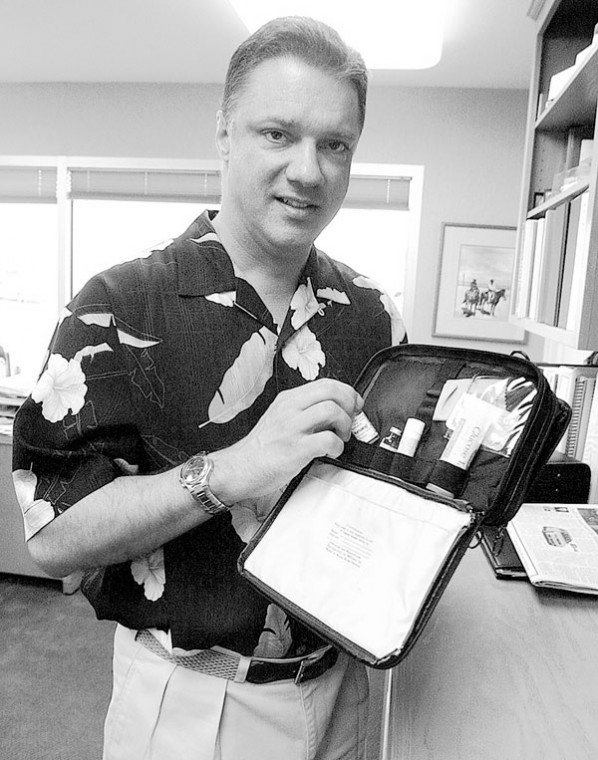It started with sweating and frequent trips to the bathroom. But
even when Don Gage cut down on evening drinks like water and tea,
the symptoms didn’t go away. Eventually, Gage, 59, went to the
doctor and was stunned when he heard the diagnosis.
It started with sweating and frequent trips to the bathroom. But even when Don Gage cut down on evening drinks like water and tea, the symptoms didn’t go away. Eventually, Gage, 59, went to the doctor and was stunned when he heard the diagnosis. Diabetes, the doctor told Gage, who was only 35 at the time.
Today, Gage – who has served on the Santa Clara County Board of Supervisors since 1997 and as mayor of Gilroy for six years before that – starts every day with two diabetes medications and an insulin shot, which he injects in his lower abdomen. Fifteen minutes later he eats breakfast and heads out the door for a day of politics at the office. In the evening, it’s same routine – pills, shot and food, in that order, to prevent hypoglycemia, a low blood sugar reaction when insufficient sugar in the brain, the result of not eating, mixes with too much insulin, such as after a shot.
When Gage travels, as he sometimes does for work, he carries his insulin and syringes with him, along with a note from his doctor authorizing him to carry the needles despite new airline regulations. And when he arrives at his hotel, he immediately fills the ice bucket and throws on his packets of insulin to keep them cold.
“The major thing I’ve learned is that you can live with this,” said the Gilroy native. “It’s inconvenient, but it’s not like you have to go on dialysis. But you do have to pay more attention to your body.”
Across California, 1.5 million people suffer from diabetes and that number is growing, say San Benito County Department of Health officials. Today, half of the newly diagnosed are kids, a shock to people like Lynn Kjelson, a dietitian and diabetes manager at Hazel Hawkins Hospital in Hollister.
“Children are much more inactive than they used to be,” said Kjelson. “Many are going away from eating dinner with their families, drinking a lot more soda and sitting around more.”
Combine the sluggish lifestyle with diabetes in the family and your chances of getting the disease skyrocket, says Kjelson.
Kids in South County, similarly to those in other parts of the state, are increasingly being diagnosed with Type 2 diabetes. Type 2 diabetes occurs when the body stops properly using insulin and is typically the result of being overweight.
The origins of diabetes are still a mystery. It starts out with symptoms many overlook, like sweating, frequent urination and thirst. If left untreated, the disease can eventually progress into more serious health issues like glaucoma, heart disease and nerve damage to feet and hands which can result in amputation of the feet and legs.
Gage knows that as a diabetic, it is harder for him to heal from a cut because his blood is slower to reach the outer parts of his body like hands and feet. That’s why he never walks around barefoot and regularly goes to the doctor to check his eyes, feet and endocrine system to make sure his health is steady. He also rides his bike to stay in shape and is extremely cautious about what he eats.
“I eat meat, fish, salads, but skip the gravy,” said Gage. “And almost never have dessert.”
But it’s not only the sugar Gage is only worried about. Carbs, which doctors have realized are potentially more lethal to diabetics because they are made of sugar molecules that increase blood sugar levels, also are on his list of foods to watch. That is why diabetics are urged to cut down on pasta, bread and other baked goods and increase the number of vegetables and protein they eat.
Adapting to life as a diabetic may be hard, but it can be done. Just ask Scott Lynch, who was only 11 when he was diagnosed with the disease. Lynch, president and part owner of Bob Lynch Ford in Gilroy pricks his finger with what’s called a lancet up to five times a day to make sure his blood sugar is within limits. He also gives himself injections of long-lasting insulin twice a day and another type just before he eats.
“Over time you adapt,” says the 43-year-old father of two. “Initially I was very shy about it and would step away to the bathroom to take my shot. Now I have gotten to the point where I know I am a diabetic and have a reason to take the medication and will do so in public and not feel the need to excuse myself.”
He still gets inquisitive looks from employees who don’t know he’s diabetic when they see him giving himself an injection. But once he tells them about diabetes and the treatment for it, they loosen up, he said.
“I am open to sharing about it,” said Lynch.
Diagnosis of diabetes starts with the Glucose Tolerance Test that checks a person’s blood sugar level. Anything over 100 is considered pre-diabetic and 126 and higher is full-blown diabetes. Once a diagnosis has been made, the newly-pronounced diabetic is instructed in everything from how to give themselves a shot to what can happen if they miss one. And unlike in years past, pre-diabetics are given medications to keep their blood sugar in check so they don’t develop full blown diabetes.
Diabetes does not discriminate. It affects the young and old, men and women and people of all races. However, studies have shown a strong correlation between level of income and who gets diagnosed with the disease and how early or late in the game. For example, 24 percent of Latino seniors in California suffer from diabetes compared to 14 percent non-Latino seniors, according to a study by the UCLA Center for Health Policy Research done in 2003. Additionally, 10.3 percent of African-Americans and 9.3 percent of American-Indians suffer from diabetes compared to only 5.6 percent of whites, the study found.
The reason the groups are prone to diabetes is a diet high in carbohydrates and fat and a history of the disease, said Hazel Hawkins’ Kjelson. However, inadequate access to proper diabetes prevention and poor quality of care are other reasons for the higher numbers, according to the UCLA study.
“If diabetes services, such as education and eye evaluation, are not available, then programs to reduce the burden of diabetes will not be accessed and used. Many diabetes “at-risk” groups reside in medically under served areas and/or are not insured,” according to the study.
Combating the problem of access is one of the objectives of the San Benito County Diabetes Collaborative, a multi-pronged campaign to target diabetes in that county. The group is made up of Hazel Hawkins Hospital staff, the San Benito County Health Department, school officials and members of the community, all working the goal of finding ways to stop the diabetes epidemic from spiraling out of control.
“We are looking at everything – from counting four celery sticks instead of four pies in math class to figuring out if Jenny Craig or the gym works best for someone,” said Muree Reafs, director of nursing at the Health Department, who is at the forefront of the collaborative.
Three thousand people in San Benito County currently live with diabetes, which costs the city of Hollister more than $19 million a year. In Santa Clara County, that number is over 6,000, according to statistics provided by the Santa Clara County Department of Health. Across the country, more than 18 million people have been diagnosed with the disease and an estimated 41 million are considered pre-diabetic.
The cost of treating diabetes is high for not only health agencies, but also for people living with the disease. Every month, there are syringes, insulin and lancets (small needles used to prick finger), which are almost never entirely covered by insurance. And if someone is on public insurance plan such as Medicaid or Medical, the costs are typically higher. Lynch, the manager of Scott Lynch Ford in Gilroy, for example, has a private health insurance. Yet he still pays approximately $150 a month in co-pays for the supplies he needs. Supervisor Gage’s costs run a bit smaller. He pays up to $100 over three months for his supplies, he said.
Both men say they have gotten used to living with diabetes and still have productive, fulfilling lives, surrounded by family and friends. However, there are things they know they just can’t do. For example, Lynch manages his weight by walking and going to the gym three times a week. Gage can’t go on any extended trips into the wilderness because he has to have a constant supply of insulin, which will spoil if not kept cold. And he usually skips the cocktail parties at work or during business trips and heads straight to dinner, since he has to eat after giving himself a shot.
However, he occasionally relaxes his austere regimen to enjoy the good things in life. That’s why when he turns 60 this April 8, Gage will have no holds barred.
“I know I’ll be eating both ice-cream and cake,” he said.
Diabetes
• Type 1 Diabetes: Results from body’s failure to produce insulin, the hormone that “unlocks” the cells of the body, allowing glucose to enter and fuel them. Only 5-10 percent of Americans are diagnosed with this type of diabetes.
• Type 2 Diabetes: Results from insulin resistance (a condition in which the body fails to properly use insulin) combined with relative insulin deficiency. 90-95 percent of Americans diagnosed with this type of diabetes.
Resources:
American Diabetes Association
www.diabetes.org
Centers for Disease Control- Diabetes branch
www.cdc.gov/diabetes














